National Referral Mechanism statistics UK, quarter 1 2020: January to March second edition
Updated 18 March 2021
This statistical bulletin gives a summary and breakdown of the number of potential victims of modern slavery referred into the National Referral Mechanism (NRM) from 1 January to 31 March 2020 (quarter 1). Please also refer to the data tables that are published alongside this bulletin for further data.
Key results
In quarter 1 2020, 2,864 potential victims of modern slavery were referred to the NRM; a 14% decrease from the previous quarter, but a 33% increase from the same quarter in 2019.
Of the 2,864 potential victims, 60% (1,724) claimed to have been exploited in the UK only, whilst a quarter (754) claimed the exploitation took place overseas only.
Just over half (52%) of the referrals were for individuals who claimed they were exploited as adults, with the remainder claiming they were exploited as children (42%) or their age at exploitation was unknown (5%).
Labour exploitation was the most common exploitation type for adult potential victims, whilst criminal exploitation was most commonly reported for child potential victims.
Potential victims from the UK, Albania and Vietnam were the three most common nationalities to be referred to the NRM, as in the previous quarter.
The majority (92%) of referrals were transferred to police forces in England for investigation, 4% were sent to Police Scotland, 3% were sent to Welsh police forces and 1% to the Police Service of Northern Ireland.
Number of quarterly NRM referrals from 2014 to 2020
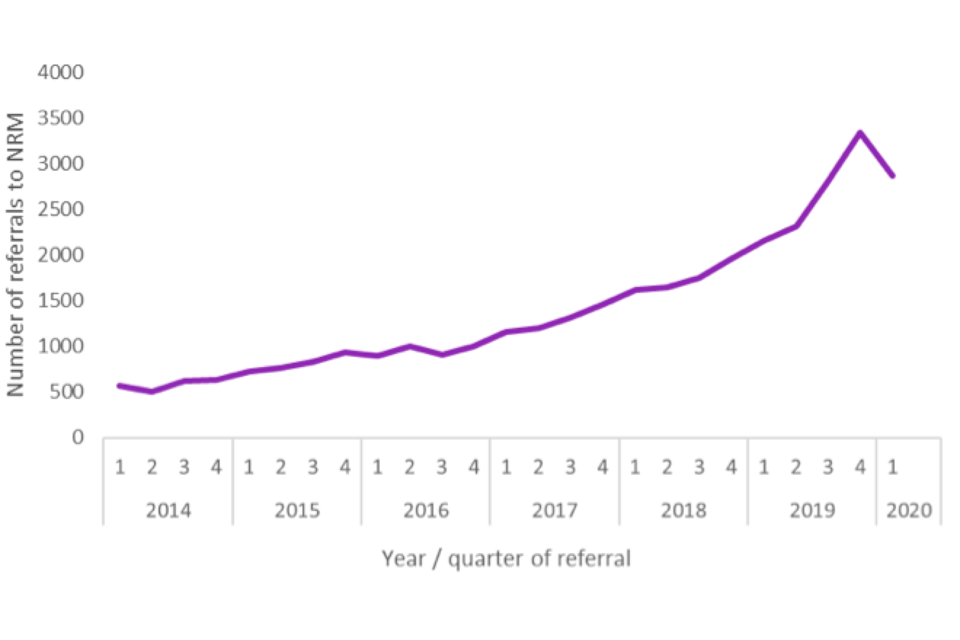
1. Introduction
Modern slavery is a term that includes any form of human trafficking, slavery, servitude or forced labour, as set out in the Modern Slavery Act 2015. Potential victims of modern slavery in the UK that come to the attention of authorised ‘First Responder’ organisations are referred to the National Referral Mechanism (NRM).
Authorised ‘First Responder’ organisations include local authorities, specified non-governmental organisations (NGOs), police forces and specified government agencies. Adults (aged 18 or above) must consent to being referred to the NRM, whilst children under the age of 18 do not need to give consent to be referred. NRM referrals can also be made for individuals exploited as children but who are now adults.
Once referred to the NRM, the Single Competent Authority (SCA) within the Home Office is responsible for making a ‘reasonable grounds’ decision on whether or not an individual could be a victim of modern slavery.
Adults who are given a positive ‘reasonable grounds’ decision have access to support (including accommodation, subsistence, legal aid and counselling) until a ‘conclusive grounds’ decision on their case is made. Children are supported by local authorities.
Adults with a positive ‘conclusive grounds’ decision are currently entitled to at least a further 45 days of support to allow them to ‘move on’ from NRM support, whilst those with a negative decision receive 9 days of support. See further information regarding the NRM process.
User feedback survey
The user feedback survey on NRM statistics ran for 6 weeks and closed on 1 May 2020. We received 50 responses from a range of stakeholders and would like the thank those who responded. We have made some of the suggested changes in this statistical bulletin (outlined below) and will be considering further changes to future bulletins that will be highlighted in each of the releases:
-
Additional commentary throughout the bulletin, detailing a breakdown of key statistics by age group at exploitation.
-
Additional graphs in the bulletin (further visualisations may be added in future bulletins).
-
Expansion of the time series data provided in table 1 of the data tables released alongside this bulletin to include referrals split by age group and location of exploitation.
-
Expansion of police force data in table 8 of the data tables to include data split by age group at exploitation.
Please email NRMStatistics@homeoffice.gov.uk if you have any further comments or questions regarding these statistics.
Correction
An error in data processing was identified that resulted in the incorrect classification of some exploitation types, primarily sexual exploitation, as ‘Not recorded or unknown’. This has been corrected in the updated bulletin/data tables using an updated cut of data taken 1 February 2021. This error is related to data processing for the statistical bulletins, and did not affect the classification of referrals within the NRM system itself.
2. Q1 National Referral Mechanism statistics
Number of referrals by age group
In the first quarter of 2020, the NRM received 2,864 referrals of potential victims of modern slavery. This represents a 14% decrease in referrals compared to the previous quarter (3,344), but a 33% increase from quarter 1 in 2019 (2,154). This is the first quarter-on-quarter decrease in the number of referrals since the third quarter of 2016 (data table 1). The decrease in this quarter is understood to influenced by the effects of restrictions implemented in the UK as part of the response to the COVID-19 pandemic.
The number of quarterly NRM referrals for both adults and minors has increased at a similar rate from 2014 to 2019, though there has been a decrease in both adult and minor referrals in the first quarter of 2020. As in the previous quarter, just over half (52%; 1,490) of the NRM referrals were for potential victims who claimed they were exploited as adults, whilst 42% (1,217) claimed to have been exploited as children (Figure 1). The age group at exploitation was not known in 5% of cases (157).
Figure 1: Number of quarterly NRM referrals by age group of exploitation, 2014 to 2020
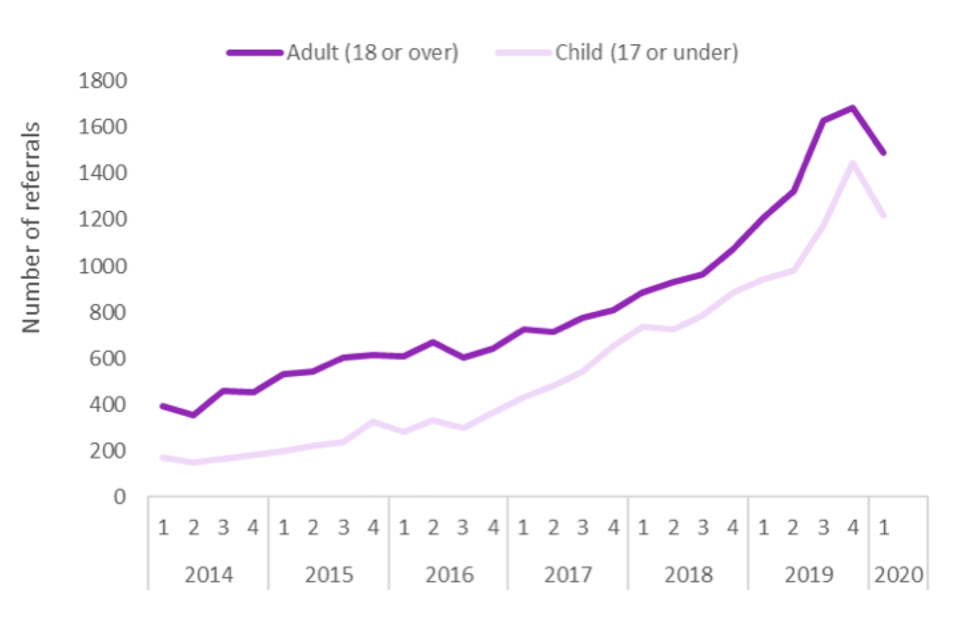
Source:SCA
Notes: Excludes data pre-2014 due to data reliability. Referrals where the age group at exploitation is unknown are not shown.
Location of exploitation
Quarterly NRM referrals for potential victims exploited in the UK only and overseas only have increased from 2014 to 2019, though fell in the first quarter of 2020 (Figure 2). The number of referrals for those with an unknown location of exploitation has remained fairly constant but decreased since the third quarter of 2019. Overall in quarter 1 2020, 60% (1,724) of potential victims claimed they were exploited in the UK only, whilst 26% (754) claimed to have been exploited overseas only (data table 2; Figure 2). Referrals of potential victims who claimed to have been exploited both in the UK and overseas (13%; 375) were the only category to slightly increase compared to the previous quarter.
Figure 2: Number of quarterly NRM referrals by location of exploitation, 2014 to 2020
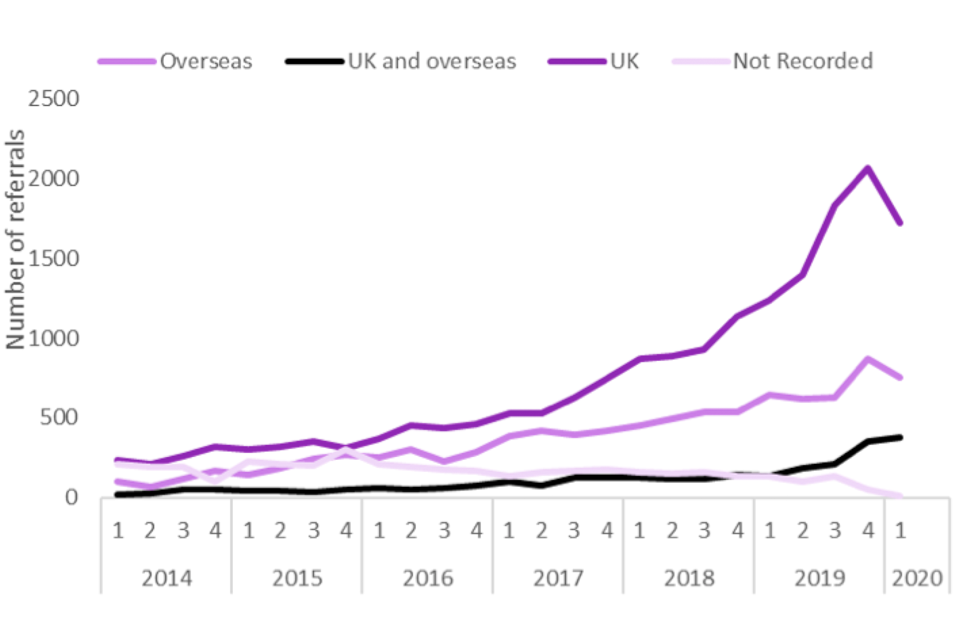
Source: SCA
Notes: Excludes data pre-2014 due to data reliability.
A higher proportion of child potential victims (67%; 819) claimed they were exploited in the UK only, compared to adults (57%; 843). A slightly higher proportion of adults claimed the exploitation took place overseas only (28%; 421) compared to child potential victims (22%; 271).
Referrals by gender and exploitation type
Overall, of the 2,864 potential victims referred this quarter, 72% (2,059) were male and 28% (789) were female. For adult potential victims, 68% (1,009) were male and 32% (475) were female, whilst for child potential victims, 76% (928) were male and 23% (281) were female.
Changes to recording of exploitation type
Prior to 1 October 2019, potential victims of modern slavery were recorded as having a single ‘primary’ exploitation type, grouped into five distinct categories: labour, sexual, domestic servitude, organ harvesting or unknown exploitation (Figure 3). Following changes to the way NRM data is collected, recording of exploitation types has changed to give a better picture of the exploitation experienced by potential victims. As a result, for referrals received from 1 October 2019, criminal exploitation has been split from labour exploitation. In addition, potential victims can be also be recorded as experiencing multiple exploitation types and, as such, caution should be taken when comparing exploitation type statistics from quarter 4 with previous quarters, as the primary exploitation type is unknown. Furthermore, some breakdowns provided in previous statistical releases by certain characteristics and exploitation type have not been provided in the data tables to avoid comparisons with previous quarters.
Figure 3: Changes introduced to recording procedure of exploitation types in the NRM, from 1 October 2019
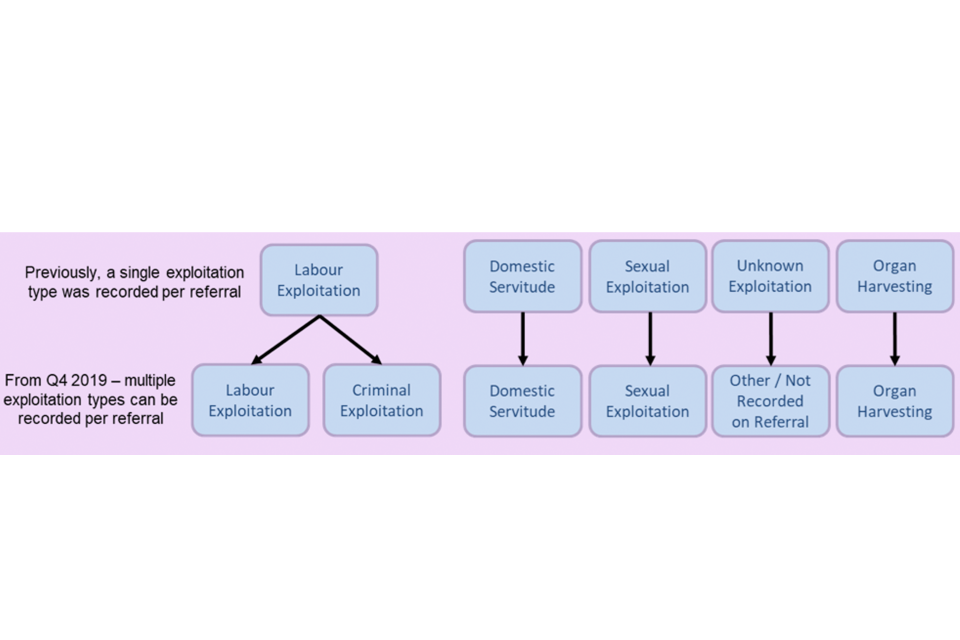
It is important to note that the exploitation types recorded in this statistical bulletin are those that are reported for potential victims at the referral stage.
Overall, potential victims were most commonly referred for criminal or labour exploitation, accounting for 28% (791) and 24% (699) of all referrals respectively. An additional 11% (306) of referrals stated that potential victims had been exploited for both labour and also criminal exploitation. Sexual exploitation accounted for 13% (374) of all referrals, with a further 9% (257) of referrals including sexual exploitation in combination with other exploitation types.
For adult potential victims, labour exploitation was most commonly reported (33%; 493), and the majority of those potential victims (90%; 445) were male. However, for child potential victims, criminal exploitation was most common (44%; 532) and the majority (93%; 497) of those were male. Most potential victims of sexual exploitation were female for both adults (91%; 208) and children (79%; 99). See further information on types of exploitation.
For those exploited as children, criminal exploitation is partially driven by an increase in the identification of ‘county lines’ cases. ‘County lines’ is used to describe drug gangs in large cities expanding their reach to small towns. In many cases, vulnerable individuals are exploited to transport substances, and mobile phone ‘lines’ are used to communicate drug orders. See further information on county lines.
Referrals by nationality
As in previous quarters, the most common nationality referred were UK nationals, which accounted for a quarter (751) of all potential victims referred. A large proportion of referrals for UK nationals were children. The second most commonly referred nationality was Albanian (19%; 536). The majority (79%; 592) of referrals for UK nationals were for child potential victims, whilst for Albanian nationals, the majority (81%; 432) were potentially exploited as adults (Figure 4).
Please note that a change to data recording means that as of 1 October 2019 the dual nationality of potential victims is reflected in NRM data in separate categories. To see total counts of a particular nationality, please refer to the data tables.
Figure 4: Number of NRM referrals for the most common nationalities of potential victims in Q1 2020, by age group at exploitation; the top 10 nationalities shown here account for 70% of referrals
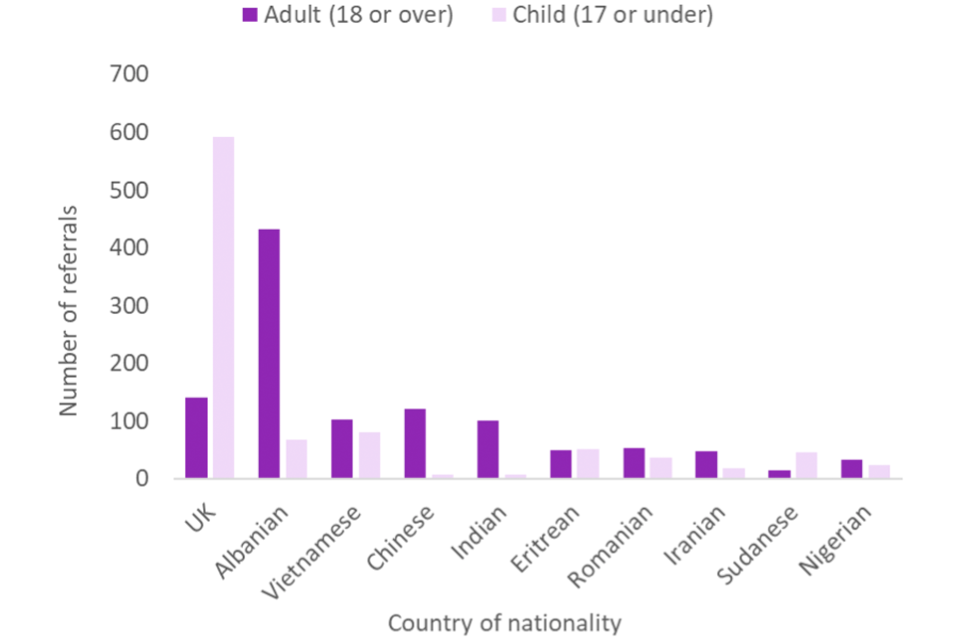
Source: SCA
Notes: Potential victims with an unknown age at exploitation are not shown. There are separate categories for dual-nationals.
Referrals by location of crime investigation
Once the SCA receives an NRM referral, it determines the responsible geographic police force for investigation based on the information provided on the referral form. Once the relevant police force is identified, the referral is transferred for investigation. As further information is gathered, it can mean the police force for a referral is updated in the case-working system, and this will be reflected in the statistics.
As in previous quarters, most (92%; 2,632) of the NRM referrals were sent to police forces in England; additionally, 4% (105) were sent to Police Scotland, 3% (92) were sent to Welsh police forces and 1% (30) to the Police Service of Northern Ireland (data table 2). A third of all referrals (948) were sent to the Metropolitan Police Service.
First responders
Authorised ‘First Responder’ organisations include local authorities, specified NGOs, police forces and specified government agencies. In quarter 1 2020, 43% (1,245) of the referrals came from government agencies (compared to 47% in Q4 2019). Of these, 53% came from Home Office Immigration Enforcement (661) and 42% from UK Visas and Immigration (528), with the remainder (56) from UK Border Force (Figure 5, data table 9). Potential victims exploited as adults are most often referred to the NRM by Home Office Immigration Enforcement, UK Visas and Immigration or the police.
Figure 5: Number of NRM referrals by First Responder types
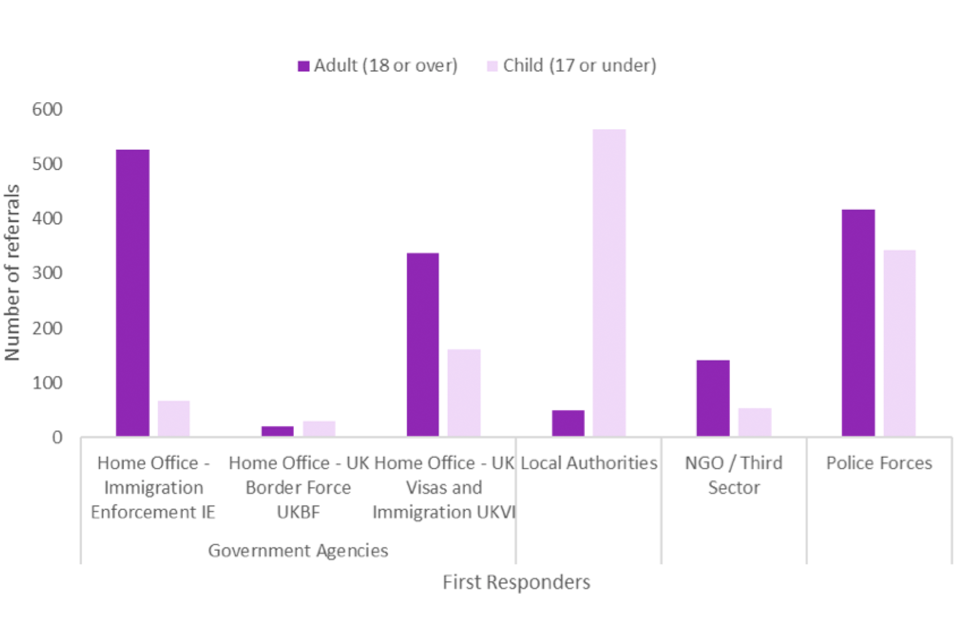
Source: SCA
Notes: Potential victims with an unknown age at exploitation are not shown.
As in the previous quarter, the police accounted for just over a quarter (788) of NRM referrals in quarter 1. NGO/third-sector organisations accounted for 7% (203) and local authorities 22% (628), the majority of which were for child potential victims (Figure 5, data table 9).
3. Further information
Quality information
All percentages are rounded to the nearest whole percentage point.
It is important to note that the statistics presented in this publication relate to the number of potential victims of modern slavery that have been referred to the NRM.
The statistics provided are taken from a live management information system and based on the situation as at 1 February 2021, when an extract was taken from the system. The figures presented here may differ from previous or future reports as new information comes to light and cases are updated accordingly.
NRM statistics were previously published by the National Crime Agency (NCA), prior to transfer of NRM decision-making responsibilities to SCA in April 2019 as part of the NRM Reform Programme. Publications prior to July 2019 can be accessed via the NCA website. With this transfer of responsibility, these data are now designated as official statistics and produced in line with the Code of Practice for Statistics.
Data tables for further analysis can be found online alongside this bulletin.
This statistical bulletin is produced to the highest professional standards and is free from political interference. It has been produced by statisticians working in the Crime and Policing Analysis Unit in accordance with the Home Office’s Statement of compliance with the Code of Practice for Official Statistics, which covers Home Office policy on revisions and other matters. The Chief Statistician, as Head of Profession, reports to the National Statistician with respect to all professional statistical matters and oversees all Home Office National Statistics products with respect to the Code, being responsible for their timing, content and methodology.
Police force data provided in associated reference tables are based on the location of the police force that received the NRM referral. Each referral is screened against the criteria below to identify the responsible geographic police force. Once identified, the referral is transferred to the relevant Force Intelligence Bureau, or stipulated point of receipt within the force for action. In some cases, further information is received and processed regarding a referral which means it will be sent to a different police force. This will be reflected in the updated statistics.
Criteria applied to identify the relevant police force:
*the force has acted as First Responder, or the referral indicates that the force is already involved in the recording/investigation of the potential modern slavery human trafficking offences; or
-
the potential victim has been exploited within the force area; or
-
the potential victim has been exploited abroad, or at an unknown location and the victim’s address at time of referral is within the force area; or
-
the potential victim has been exploited abroad or at an unknown location and they have presented to another First Responder within the force area.
Other related publications
National Referral Mechanism Statistics Quarter 2 2019 – April to June
National Referral Mechanism Statistics Quarter 3 2019 – July to September
National Referral Mechanism Statistics Quarter 4 2019 – October to December
National Referral Mechanism Statistics UK, End of Year Summary, 2019
Feedback and enquiries
We welcome feedback on statistics releases. If you have any feedback or enquiries about this publication, please contact NRMStatistics@homeoffice.gov.uk.
